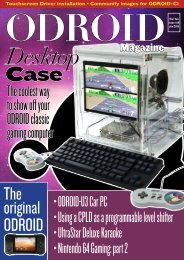Lamp
ODROID-Magazine-201509
ODROID-Magazine-201509
- No tags were found...
You also want an ePaper? Increase the reach of your titles
YUMPU automatically turns print PDFs into web optimized ePapers that Google loves.
obotic companion<br />
Kinematics diagram<br />
points in advance for calculating the Bézier curve.<br />
Therefore, the detected face position is not valid anymore<br />
when the Kinematics module is sending a position<br />
to the servos a couple of seconds afterwards. The<br />
solution is to permanently compute the current 3D<br />
position and send that to the Kinematics module, in<br />
order to change the head orientation towards the face<br />
in real-time.<br />
C.angle := A.rotation.z + 270° -<br />
acos( C.point.y-E.point.y / C.distance(E) )<br />
These angles are passed via I2C to the ATmega, where the<br />
Arduino library generates a 60Hz PWM signal for the servos.<br />
In the beginning, I was concerned about the high CPU use<br />
of 3D kinematics, and tried to implement it with fixed point<br />
integers and interpolated trigonometry, since I was used to a<br />
24MHz ATmega. What a surprise it was when I recognized<br />
that using floats and sin/cos with no caching or table lookup<br />
had no noticeable performance impact.<br />
Facial recognition<br />
The facial recognition module uses OpenCV 3.0 with Haar<br />
cascade classifiers. Although the newer LBP cascades are significantly<br />
faster, they had many more false positives, so I thought<br />
10 fps with Haar cascades is sufficient. From the 2D position<br />
of the detected face, the 3D position is estimated assuming a<br />
standard face size, which worked surprisingly well. Later on,<br />
Luci’s trajectory planning module moves towards the face if it<br />
is very close, in order to simulate real interest, then moves away<br />
if it violates the European intimacy distance. Tracking a face<br />
in real time was a bit tricky, since grabbing images from the<br />
video stream and facial recognition has a latency of 250ms .<br />
So, the computation of the face’s 3D position needs to be done<br />
relatively to the webcam’s position 250ms ago. Consequently,<br />
when Luci moves quickly, this does not work well when the<br />
image becomes blurry, so the orientation of the head is directed<br />
towards the last stable face position until Luci moves slower<br />
and following the face in real time becomes possible again.<br />
The trajectory planning module computes the next two<br />
Conclusions<br />
Similar to my experience with my work at my job,<br />
everything just took longer than expected. Surprisingly,<br />
the software and hardware worked out quickly, but<br />
getting the construction and the mechanics in a shape<br />
that worked without being too heavy, with properly<br />
mounted servos and springs, took me a couple of weekends<br />
in the basement. The mathematics were definitely<br />
challenging. Getting facial recognition done was the<br />
simplest part, but gets the most ahhs and ohhs. The guys from<br />
OpenCV did a pretty good job at making this really easy. The<br />
most fun part was the trajectory planning, such as how Luci<br />
should move when the webcam recognizes a face moving.<br />
I have been thinking of enhancing Luci with a microphone<br />
and a beat detection module allowing her doing cool moves<br />
according to the music. My first thought was that it wouldn’t<br />
be difficult, but rhythm detection seems to be extremely tricky.<br />
Parts List<br />
ODROID-U3 running Ubuntu 14.04.02 with the latest g++<br />
compiler<br />
Software uses OpenCV 3.0 and Boost 1.57 as base libraries<br />
ATmega 328 running C++ firmware based on Arduino Library<br />
for Servos and I2C<br />
Servos from Hitec: 77B (for turning base & nicking the<br />
head), 7954SH (lower strut, strong & expensive), 7775MG<br />
(upper strut, also expensive), 5065MG (turn head inside the<br />
lampshade)<br />
3D print of a TurboCAD model made of ABS<br />
Springs from my local dealer, 20 ball bearings, 0.5m2 multilayered<br />
birch, and several brass axis<br />
Source code on http://bit.ly/1iq9amT<br />
Other projects<br />
Two years ago, I was bored by using Excel too much at the<br />
office, since I’m a professional software architect, so I started<br />
learning electronics and embedded technology and made my<br />
first robot, which can be viewed at http://bit.ly/1VHg7OX.<br />
His name is Paul, and it balances on a ball.<br />
ODROID MAGAZINE 23



